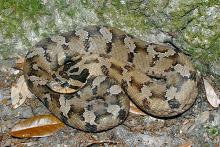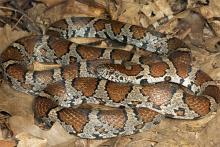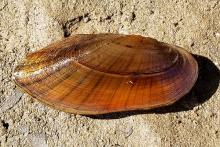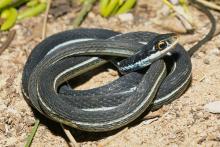
Eastern Hellbender
Scientific Name: Cryptobranchus a. alleganiensis
Classification: Nongame species; state listed as special concern
Range/Abundance: Rare
Photo Credit: Lori Williams
A selection of species found in North Carolina.

Scientific Name: Cryptobranchus a. alleganiensis
Classification: Nongame species; state listed as special concern
Range/Abundance: Rare
Photo Credit: Lori Williams

Scientific Name: Heterodon platirhinos
Photo Credits: Brad Moon
Usually brown or gray with dark brown blotches, the Eastern Hognose Snake has an upturned nose to dig for toads. They are non-venomous with enlarged teeth for swallowing. The snake, when threatened, will play dead by opening its mouth and rolling on its back.


Scientific Name: Lampsilis radiata
Classification: State Threatened
Photo Credits: Michael Perkins

Scientific Name: Lampropeltis triangulum triangulum
Photo Credits: Todd Pierson
Living on wooded slopes, the Eastern Milksnake is usually gray or brown with reddish blotches on its back. They eat small snakes, lizards, and mice and are non-venomous.The Eastern Milksnake is usually found hiding under large stones.


Scientific Name: Gastrophryne carolinensis
Classification: Nongame species
Range: Found in the Coastal Plain and Piedmont (blue)
Photo Credit: Jeff Hall

Scientific Name: Notophthalmus viridescens
Classification: Nongame species
Abundance: Common statewide (dark blue denotes
range of red-spotted newt; light blue denotes range of
broken-striped newt.)

Scientific Name: Chrysemys picta picta
Classification: Nongame species
Photo Credit: Jodie Owen

Scientific Name: Ligumia nasuta
Classification: State Threatened
Photo Credits: Michael Perkins

Scientific Name: Thamnophis sauritus
Photo Credits: Richard Barlett
Found near canals, streams, ponds and marshes, the Eastern Ribbon Snake is fast-moving. It eats small frogs and salamanders and is non-venomous. Brown with three light stripes, the ribbon snake is active during the day and a great swimmer.

Scientific Name: Scaphiopus holbrookii
Classification: Nongame species
Range: Most common in Coastal Plain & Piedmont (blue)
Photo Credit: Jeff Hall


Scientific Name: Spilogale putorius
Classification: Furbearer
Abundance: Found in the mountains and western Piedmont
Photo Credits: Neil Pearson

Scientific Name: Ambystoma tigrinum
Classification: Nongame species-State listed as threatened
Abundance: Range is shaded in blue (parts of Wake
Hoke, Scotland, Robeson and Moore counties only)
Photo Credit: Jeff Hall